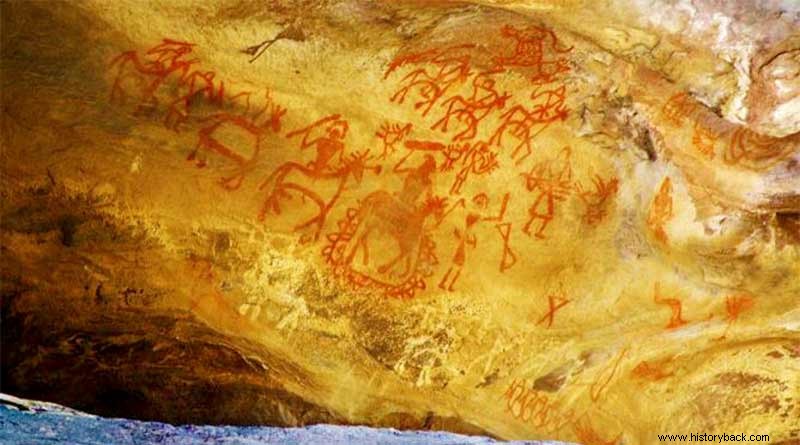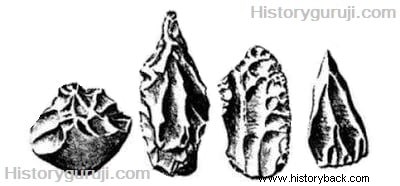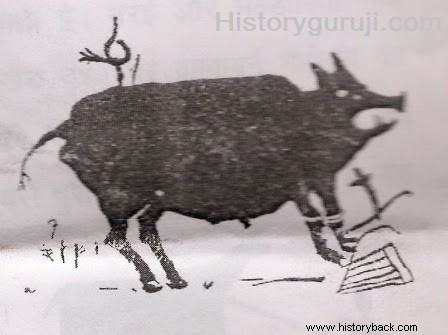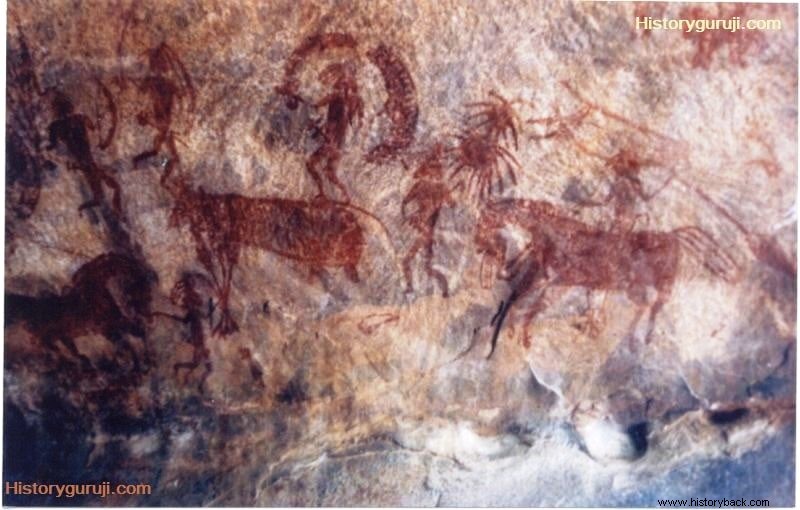The development of human civilization was not sudden or rapid, but was gradual and slow and it had to pass through many stages to reach the modern stage of development. This long period of development of civilization is divided into three periods - prehistoric period, prehistoric period and historical period.
The term 'prehistory' was first used by Wilson in the late nineteenth century AD. 'Prehistoric The word denotes a period that appeared with human-like beings and ended before the advent of the historical period. The man of this period did not have the knowledge of the art of writing. In other words, 'prehistory ' That is the period for which there is no written source for study and archeology is the only means for the study of such ancient society and culture.
'Proto or Prehistory ' Period is that period for which written sources are available for study, but the script of those written sources has not yet been read. The Harappan civilization and the Vedic culture are placed under this period. The period for which written sources are available in the form of articles and inscriptions for study is 'historic period' called.
Mahakalpa
Earth's geological timetable is divided into Mahakalpas. Each Mahakalpa is divided into many Kalpas and each Kalpa is divided into many Yugas. The geological mega-kalpa we are living in today, this is the last mega-kalpa of the earth, the new life mega-kalpa. It started sixty-five million years ago, when different parts of the Earth acquired their present form. Before this megakalpa, all the continents of the Earth were connected to each other and were in the form of a huge landmass called 'Pangaea' Having said. The new life cycle is divided into two kalpas - tertiary and quaternary. The Tertiary Kalpa is divided into five Yugas-
- The Archaic Era (80 million years ago),
- modern era (six million years ago),
- The Neolithic Age (30 million years ago),
- Medieval Era (two million years ago) and
- The Neolithic Era (fifty-two million years ago).
of human life gradual development (Gradual Development of Human Life)
The evolution of primitive man/male-ape began 70 million years ago. The evolution of bipedalism occurred in the late Middle Ages, making it possible for the origin of Australopithecus. The evolution of the Homo branch occurred during the Late Age, and about five million years ago, primitive humans began their cultural life by making tools based on their intelligence.
More development in tool-making occurred in the later period of the fourth kalpa. The Fourth Kalpa is a subdivision of the present geological super-kalpa new life. This kalpa is divided into two geological epochs - the first extremely new age (from sixteen lakh forty thousand years ago to twelve thousand years ago) and the second minimum age (from twelve thousand years ago to the present).
During the New Age, the temperature of the entire world decreased, resulting in the arrival of a series of ice ages. From about six million years ago to twelve thousand years ago, there were four snowstorms on Earth. The last ice age ended twelve thousand years ago. Then came the minimum age. During the Very New Age primitive man was developing biologically and was now ready for cultural adaptation. During this time stone-tool technology also changed and improved.
Stone Age
The earliest period of human civilization on Earth is referred to as the prehistoric period, which encompasses a large part of human cultural development. In 1833 AD, the French archaeologist Paul Ternel called 'period and-historic' word was used. Today this word has reduced to prehistory in English and prehistoric period in Hindi. The early humans had two difficult problems- one to arrange food and the other to protect themselves from animals. Humans used the most accessible stone blocks in river basins to hunt for food, to pluck wild fruits and tubers, and to protect themselves from animals. In the early stages of civilization, humans (Homo sapiens sapiens) made stone tools, as stone was readily available to them. To study the prehistoric period, only stone tools have been obtained in the form of an archaeological source in the largest quantity. Due to the predominance of stone-tools and human dependence on them, this early period is called 'Stone Age' called.
Research of Paleolithic culture in India first started in 1863 AD when Robert Bruce Foote, who is called the father of Indian prehistory, from a place called Pallavaram near Madras, started the Paleolithic period. discovered a hand-axle of . By the end of the nineteenth century many sites of prehistoric culture came to light from sites in Madras (present-day Chennai), Bombay (present-day Mumbai), Madhya Pradesh, Orissa, Bihar and Uttar Pradesh and also from Mysore, Hyderabad, Rewa, Talcher etc. D. Terra and Patterson's instructions in 1935 surveyed the plateau part of Shivalik's Potwar and found many Palaeolithic tools there.
There is a long range of human use of stone tools. From rough stone tools to sophisticated stone tools, the developing intelligence of human beings is easily reflected. This period of human-civilization is mainly divided into three parts and each period indicates its own characteristics and the gradual development in the technique of making tools-
- Paleolithic Age
- Mesolithic Age
- Neolithic Age
Where humans used flake of heavy and contrasting tools in the Palaeolithic period, the Mesolithic period saw the introduction of microlithic tools. The basic element of the economy of the Neolithic period was the knowledge of food production and domestication of animals. Evidence of pottery for the first time in this period See you.
Paleolithic Age

Paleolithic culture developed in the very New Age. The Paleolithic Age is called the 'Paleolithic Age' Which is called 'paleos of the Greek language. ’ and ‘Lithos ', which means - old stone. Stone tools extracted from the scales of the Palaeolithic period have been found in large numbers from different parts of India. Tools of this period A type of hard stone quarry
Composed of eterjite, hence the Paleolithic man in India is called 'quartzite man ' is called. On the basis of stone tools, it is estimated that their period is roughly five lakh to eight thousand BC. will be around.
Paleolithic human remains have not been found in India, but in December, 1982, a human from a site called Hathnaura located in the Narmada river valley in Hoshangabad district of Madhya Pradesh Skull (brain) fossil Which has helped in understanding Indian prehistoric culture. Anthropologists attribute this brain to the Homo erectus group, while some consider it evidence of Homo sapiens. Although the date and time of this Narmada man is not known, yet it can be considered as evidence of Lower Palaeolithic man as this skull has been excavated along with the tools of that period. Maharashtra's Bori It has been estimated from the remains found in the excavation of a place that the presence of man on this earth is about fourteen million years old. Roughly, the existence of humans in India must have been between the Indus and Jhelum rivers in Punjab about five lakh years ago.
The stone tools made of round stones are mainly found in the Sohan river valley. core and flux system of common stones The tools made by them have been found mainly in Madras (present-day Chennai). Stone tools made from these two systems have been found in Singrauli Valley, Mirzapur and Belan Valley (Allahabad). The mountain-caves and Shailashray (cave painting) found in Bhimbaithka of Madhya Pradesh are also important. The Paleolithic humans were probably of the Negro race, as are the people of the present-day Andaman Islands. The human of the Negro race is short in stature, curly hair, dark skin color and flat nose.
On the basis of the stone tools used in the Palaeolithic period, the tools-technology and the changes in climate, this period can be divided into three classes-
- Lower Paleolithic period
- Middle Paleolithic period
- Upper Paleolithic period
Lower Paleolithic period
Palaeolithic man spent most of his time in the Lower Palaeolithic. The time of this period is considered to be about five lakh years ago to one lakh years ago. In the Palaeolithic period, various types of stones, such as quartzite, chert, quartz and basalt, were used as raw materials for making tools. The tools of this period were mainly handaxes, chopping tools, cleavers and cleavers etc. are included. Lower Palaeolithic tools have been found from a large part of the whole of India except the Indus, Sarasvati, Brahmaputra and Gangetic plains.
Major sites of the Lower Palaeolithic Period
Some important sites of the following Palaeolithic period are Pahalgam in Kashmir, Belan Valley in Allahabad district of Uttar Pradesh, Bhimbaithka in Hoshangabad district of Madhya Pradesh and Adamgarh in Ahmednagar district of Maharashtra Nevasa, Hunshagi in Karnataka's Gulbarga and Attirampakkam in Tamil Nadu. The man of this period was Australopithecus who was familiar with caves, but not familiar with fire.
Middle Paleolithic period
Discovery of this era H.D. had done. Its time is believed to be around one lakh to forty thousand years ago. Humans of this period Neanderthal is believed. Humans of this period used mostly bright stones like filtrate, chert, jasper in place of quartzite. The scale tool industry is characteristic of the Palaeolithic tool technology. Under this technique Boutikash (Pebble) the scales are removed from it by hitting it. Due to the abundance of Falaks, the culture of this period was called Falak culture is called. The tools of this period include small and medium sized cleavers, cleavers and various types of scrapers, borers and knives.
The instruments of this period show regional variation on the basis of size, type and availability of raw materials. Continuity of human habitation is seen in sites where Middle Paleolithic tools have evolved from Lower Palaeolithic tools.
Middle Paleolithic Site
Middle Palaeolithic tools have been found from Central India, Deccan, Rajasthan, Maharashtra, Tamil Nadu, Karnataka and Orissa. Some of the important sites of this period are Bhimbaithka, Nevasa, Pushkar, Rohini hills of upper Indus, Samanapur on the banks of Narmada etc. The Middle Palaeolithic gradually evolved into the Upper Palaeolithic period.
Upper Paleolithic period
This period in India is called the Late Palaeolithic or Microlithic period Also called. Its time ranges from forty thousand years ago to ten thousand BC. is believed to be approx. Humans of this period probably Homo sapiens was. The rise of modern man took place in this period. The fine stone tools of this period have been made from some refined stones, such as chert, chalcedony, crystal, jasper, carnelian, agate, etc. Parallel-ended blades carefully removed from the core are characteristic of the tools of this period. This period is referred to as 'Blade Culture' because the tools were manufactured using blade technology. Also called.
The blade was a thin and narrow-shaped blade, with equal edges on both sides, but twice the width of the length. Tools made on scales and blades include sophisticated and small sized points, scrapers, and burins. Apart from this, some new types of tools also started coming into existence, such as- triangle, trapezoid, arrowheads, crescent shape e.t.c. Evidence suggests that the development of composite instruments began from this cultural stage. Upper Palaeolithic tools have been found in Rajasthan, parts of the Ganges and Belan valley, central and western India, Gujarat, Andhra Pradesh and Karnataka.
Field and type equipment

कश्मीर घाटी से लेकर प्रायद्वीपीय भारत में फैली पुरापाषाणीय संस्कृति की विभिन्न बस्तियों में पर्यावरण एवं उपकरण-तकनीक-संबंधी उल्लेखनीय अंतर पाये जाते हैं। उत्तर भारत में पंजाब में नदी-वेदिकाओं के तट पर पत्थर के टुकड़ों को उपकरणों के रूप में प्रयुक्त किया गया,जबकि दक्षिण भारत के मानव ने बड़े पत्थरों को गढ़कर हस्त-कुठार एवं अन्य उपकरणों का रूप प्रदान किया।
कश्मीर घाटी
1928 ई. में पुरातत्त्वविद् वाडिया ने इस क्षेत्र से पाषाण-उपकरणों को प्राप्त किया। 1939 ई. तक पंजाब (वर्तमान पाकिस्तान) के केवल एक भाग से पुरा पाषाणकालीन संस्कृतियों के तीन-चार स्तर प्राप्त हुए थे। इन चार स्तरों का नाम सिंधु नदी की एक सहायक नदी सोहन या सोन नदी के नाम पर प्राक् सोहन, आरंभिक सोहन, उत्तर सोहन तथा विकसित सोहन नाम दिया गया। इन स्तरों पर मुख्यतः खंडक उपकरण, शल्क उपकरण तथा फलक या ब्लेड उद्योग के उपकरण प्राप्त हुए हैं। उपकरणों के अन्य वर्गों के नाम उन उपकरणों की कार्यात्मक शैली या तकनीक के आधार पर दिये गये हैं। ये उपकरण मानव की बौद्धिक क्षमता और मानसिक विकास को प्रतिबिंबित करते हैं। सोहन घाटी से हस्तकुठार और खंडक उपकरण प्राप्त हुए हैं और इनके मुख्य स्थल हैं- अदियल, बलवल और चौंतरा।
1935 ई. में डी. टेरा एवं पैटरसन के नेतृत्व में येल कैंब्रिज अभियान दल ने कश्मीर से लेकर दक्षिणी पाकिस्तान में विस्तृत नमक-श्रृंखला का सर्वेक्षण किया और सिंधु तथा सोहन नदियों की भू-वैज्ञानिक संरचना का संबंध कश्मीर घाटी में अत्यंत नूतन युग में हिमानियों के जमने एवं पिघलने की प्रक्रिया से जोड़ा। द्वितीय हिमयुग के दौरान कश्मीर घाटी में पोतवार पठार पर भारी वर्षा हुई जिसमें पत्थर के बड़े-बड़े टुकड़े नदी के वेग में बह आये और उन पर सतह का निर्माण हुआ, जिसे ‘बोल्डर कोंग्लोमेरेट ’ कहा गया है। मानव की सर्वप्रथम उपस्थिति सिंधु और सोहन के सबसे ऊपर की सतह बोल्डर कोंग्लोमेरेट में मानी जाती है। इस स्तर में बड़े-बड़े शल्क (चाॅपर), क्वार्टजाइट के खंडित पेब्बल इत्यादि हैं। इनमें से कुछ पत्थर के टुकड़ों को उपकरणों के रूप में पहचाना गया है जो पुरा पाषाणकालीन मानव के प्रथम निर्माण है।
सोहन उद्योग के उपकरण खंडित पेब्बल और शल्क के रूप में नदी-वेदिकाओं (टैरेस) में सिंधु और सोहन की वर्तमान सतह से क्रमशः 125 मी. और 65 मी. की ऊँचाई से पाये गये हैं। ‘नदी, झील या समुद्र के किनारे के साथ नीचे की तरफ बने क्षेत्र को वेदिका (टैरेस) कहते हैं। जलवायुवीय परिवर्तन के कारण वेदिका का निर्माण होता है। वेदिका जितना ऊँचा होता है, उतना ही पुराना होता है। अंतर्हिमानी युग के दौरान कश्मीर घाटी और पंजाब के मैदानों की जलवायु में परिवर्तन हुआ, जिससे सिंधु और सोहन नदी मे अनेक वेदिकाओं का निर्माण हुआ।
द्वितीय हिमावर्तन काल में बनी वेदिका के उपकरणों को ‘आरंभिक सोहन ’ कहा गया है जिसमें हस्तकुठार जैसे क्रोड तथा शल्क दोनों प्रकार के उपकरण हैं। हस्त-कुठार ऐसा प्रस्तर-उपकरण था जिसमें कई फलक निकाल कर एक तरफ धार बनाकर हस्त-कुठार कोरूप दिया जाता था।
तृतीय हिमावर्तन काल में सोहन नदी की दूसरी वेदिका का निर्माण हुआ। इस समय के उपकरण अपेक्षाकृत परिष्कृत हैं। यहाँ भी फलक उपकरणों की प्रधानता है, किंतु इस स्तर से ब्लेड भी प्राप्त हुए हैं। 1932 ई. में कर्नल टाड ने पिंडीघेव से ब्लेड प्रकार के अपेक्षाकृत छोटे उपकरणों की खोज की। उत्तरकालीन सोहन उद्योग के उपकरण चौंतरा से प्राप्त हुए हैं। चौंतरा को उत्तर एवं दक्षिण की परंपराओं का मिलन-स्थल कहा गया है क्योंकि यहाँ से सोहन संस्कृति के आरंभिक फलक उपकरण और दक्षिण भारत की हस्त-कुठार परंपरा के उपकरण भी मिलते हैं। यद्यपि दोनों प्रकार के उपकरण एक ही स्तर के जमाव से मिले हैं, किंतु ये उसी स्तर पर अलग-अलग स्थानों से प्राप्त हुए हैं।
प्रायद्वीपीय भारत (Peninsular India)
इस क्षेत्र के अंतर्गत गंगा के मैदानों का दक्षिणी भाग आता है जो हस्त-कुठार संस्कृति का गढ़ माना जाता है। सर्वप्रथम इस संस्कृति के उपकरण मद्रास (चेन्नई) में पाये गये, इसलिए इन्हें ‘मद्रास-कुठार उपकरण’ भी कहा जाता है। 1863 ई. में राबर्ट ब्रूस फुट ने पल्लवरम् से हस्तकुठार प्राप्त किया था। हाल के शोधों से सिद्ध हो गया है कि मद्रासी परंपरा की हस्त-कुठार संस्कृति लगभग पूरे भारत के विभिन्न क्षेत्रों- आंध्र प्रदेश, मध्य प्रदेश, चेन्नई, मैसूर, महाराष्ट्र, गुजरात, पूर्वी राजस्थान, उत्तर प्रदेश के पठार क्षेत्र, पश्चिम बंगाल, सिंधु, कश्मीर, असम तथा आंध्र प्रदेश के तटीय प्र्रदेशों, तमिलनाडु और केरल आदि में फैली थी।
प्रारंभिक पाषाण काल में मानव की उपस्थिति नदी के आसपास तथा नदी घाटी से थोड़ी दूरी तक ही सीमित थी। हस्त-कुठार और अन्य उपकरण सर्वप्रथम पश्चिमी पंजाब में मिले हैं जो द्वितीय अंतर्हिमानी युग के थे। प्रायद्वीपीय भारत में ये नर्मदा के निक्षेप से प्राप्त हुए हैं जो लैटराइट मिट्टी के थे। इन निक्षेपों में लुप्त हो चुके जानवर, जैसे- जंगली हाथी, जंगली घोड़े तथा जंगली दरियाई घोड़े आदि के अवशेष भी प्राप्त हुए हैं।
प्रायद्वीपीय भारत में प्रारंभिक पाषाण काल के जो उपकरण मिले हैं, उनमें पेब्बल से बने हस्त-कुठार, गड़ासे और खंडक-उपकरण, विदारणियाँ, बुटिकाश्म के अतिरिक्त हत्थे के साथ बनाये गये उपकरण, दो धारोंवाले उपकरण तथा चोंचदार उपकरण भी शामिल हैं जो काटने और बेधने के लिए प्रयुक्त किये जाते थे। कर्नाटक के घाटप्रभा नदी घाटी में बटमदुरै से एश्युलियन संस्कृति (विशेष प्रकार के हस्त-कुठार जो फ्रांस में पाये गये थ) के हस्त-कुठार बड़ी मात्रा में मिले हैं। अनगावडी और बगलकोट घाटप्रभा के दो महत्त्वपूर्ण स्थल हैं जहाँ से प्रारंभिक और मध्य पुरापाषाण काल के उपकरण प्राप्त हुए हैं। अट्टिरमपक्कम और गुडियम (तमिलनाडु) से हस्तकुठार, शल्क, ब्लेड और खुरचनी जैसे उपकरण प्राप्त किये गये हैं। नर्मदा और गोदावरी घाटी से कुछ ऐसे जानवरों के अवशेष पाये गये हैं जो मानव द्वारा शिकार किये गये जानवरों के हैं। स्पष्ट है कि इस काल में मानव की जीवन-शैली शिकार और खाद्य-संग्रह पर आधारित थी।
पुरा पाषाणकालीन संस्कृति (Paleolithic culture)

जानवरों के अवशेष पुरापाषाण काल के मानव के खान-पान और जीवन-शैली के विषय में अधिक जानकारी प्रदान करते हैं। इस काल में मानव का जीवन पूर्णरूप से शिकार पर निर्भर था। आग और कृषि से अनभिज्ञ पुरा पाषाणकालीन मानव खानाबदोश जीवन जीता था और शिकार के लिए पूरी तरह पाषाण-उपकरणों पर आश्रित था। इसलिए यह काल आखेटक एवं खाद्य-संग्रहण काल के रूप में जाना जाता है। चयनित शिकार का इस काल में कोई साक्ष्य नहीं मिला है। कुछ स्थानों पर कुछ विशेष जानवरों के अवशेष अधिक मात्रा में मिले हैं, किंतु इसका कारण उस क्षेत्र-विशेष में उनकी अधिक संख्या हो सकती है या उनका सरलता से शिकार किया जाना हो सकता है। पौधों और जानवरों के माँस पर आधारित शिकारी खाद्य-संग्राहकों का खानपान आर्द्र और शुष्क मौसम के अनुसार बदलता रहता था।
चट्टानों पर की गई चित्रकारी, जो कहीं-कहीं पत्थरों को खोदकर की गई है, से भी प्रारंभिक मानव की जीवन-शैली और सामाजिक जीवन के विषय में जानकारी मिलती है।
उच्च पुरापाषाण काल की प्रारंभिक चित्रकारी के नमूने मध्य प्रदेश के भीमबैठका से मिले हैं। भीमबैठका से प्राप्त चट्टान पर की गई चित्रकारी शिकार की सफलता के लिए किये गये कर्मकांडों का हिस्सा है। इन चित्रों में हरा और गाढ़ा लाल रंग भरा गया है और इनमें मुख्यतः हाथी, शेर, गैंडा और वराह को चित्रित किया गया है। इन चित्रों में शिकारी गतिविधियों को दर्शाया गया है। चित्रों से पता चलता है कि इस काल में मानव छोटे-छोटे समूहों में रहता था तथा उसका जीवन पौधों और जानवरों से मिलनेवाले संसाधनों पर आधारित था। राजस्थान के बागौर से प्राप्त एक तिकोने आकार के पत्थर की व्याख्या मादा उर्वरता के रूप में की गई है।

अभी पारिवारिक जीवन का विकास नहीं हुआ था। मानव गुफाओं में उसी प्रकार रहता था जैसे संघाओं (उत्तर-पश्चिम पाकिस्तान) या कुर्नूल (आंध्र प्रदेश) में मानव चटटानों से बने आश्रय-स्थलों में रहता था। इस प्रकार के अनेक साक्ष्य मध्य प्रदेश के भीमबैठका तथा भारत के दूसरे स्थानों से भी प्राप्त हुए हैं। मानव-बस्तियाँ अधिकतर घने जंगलों और पानी के स्रोतों के निकट होती थीं। कुल मिलाकर पुरा पाषाणकालीन मानव केवल उपभोक्ता था, अभी उत्पादक नहीं बन सका था।
अगर आपको हमारा यह आलेख ‘भारत में प्रागैतिहासिक संस्कृतियाँ :पुरापाषाण काल’ पसंद आया हो तो इसको लाइक और शेयर जरूर करें। अगर कोई सुझाव हो, तो कमेंट अवश्य करें।
<प्राचीन भारतीय इतिहास के स्रोत
भारत का भौगोलिक परिचय
